

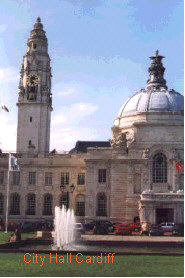 Cardiff,
the capital city of Wales is a city of 315,000 souls situated at the mouth of the river Taff (hence why sometimes
we are called Taffies or Taffy). Starting life as a sleepy little market town at the edge of a marsh it exploded
into life with the discovery of coal and iron ore in the Merthyr and Rhondda valleys. At first the coal and iron
was brought to Cardiff by pack horse and then later via the Glamorgan canal to be shipped from the small tidal
port . With the advent of the railways new docks were built and Cardiff became the largest coal exporting port
in the world.
Cardiff,
the capital city of Wales is a city of 315,000 souls situated at the mouth of the river Taff (hence why sometimes
we are called Taffies or Taffy). Starting life as a sleepy little market town at the edge of a marsh it exploded
into life with the discovery of coal and iron ore in the Merthyr and Rhondda valleys. At first the coal and iron
was brought to Cardiff by pack horse and then later via the Glamorgan canal to be shipped from the small tidal
port . With the advent of the railways new docks were built and Cardiff became the largest coal exporting port
in the world.
This brought wealth to Cardiff and it was in the Cardiff Coal exchange that the first million pound deal in the
world was struck. The decline in the coal trade also meant the decline of the wealth in Cardiff and so it has had
to reshaped itself. It has become the administrative, banking and retail centre for the whole of Wales and was
declared the capital of Wales in 1954. The development of Cardiff goes on with the
wasteland of the old docks being re-developed and of course the Cardiff bay barrage and the new Welsh assembly
building.
Today Cardiff is a city of new building, a city centre full of the latest shops and is at this very moment being
readied for the rugby world cup. Work carries on night and day to get the millennium stadium ready for this event
and is rising day by day above the river Taff. This is a wonderful stadium with a retractable roof and a grass
playing surface that can be moved on rollers so that extra seating can be installed for occasions such as pop concerts
(glad I don't live next to it). All we will need is a decent rugby side. We are very lucky as the lottery has come
up with the funds for an opera house as well and can be seen in the process of being built behind the port office.
Cardiff Port
Port office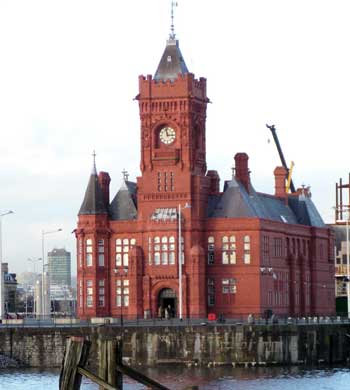
Some details from the Port Office made in terra cotta
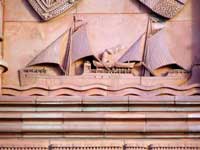
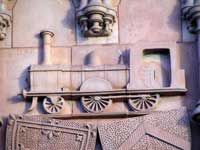
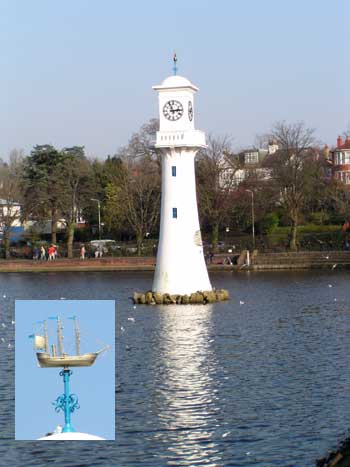 Most people
outside of the United Kingdom will never have heard of Cardiff and do not realise that once ships sailing from
the port fueled the worlds merchant navies. Most of the famous coaling ports like Valpariso and Cape Town were
supplied by little colliers sailing out of Cardiff. Even Captain Scott started his ill fated expidition to the
South Pole in June 1910 from the port and to commemorate this there is a memorial in the city's boating lake to
him and his crew. Inset is the model of the Endevour that sits on top of the memorial.
Most people
outside of the United Kingdom will never have heard of Cardiff and do not realise that once ships sailing from
the port fueled the worlds merchant navies. Most of the famous coaling ports like Valpariso and Cape Town were
supplied by little colliers sailing out of Cardiff. Even Captain Scott started his ill fated expidition to the
South Pole in June 1910 from the port and to commemorate this there is a memorial in the city's boating lake to
him and his crew. Inset is the model of the Endevour that sits on top of the memorial.
Over the years the influx of people by land, sea and air has made the population of Cardiff a very cosmopolitan one. Since the industrial revolution there has been large migrations of Irish, Cornish, Arab, a large contingent of black ex seamen and strangely a large population of Somalis. The old Tiger bay (of Shirley Bassey fame) used to be more like a united nations but for some has sadly gone replaced with maisonettes and high rise flats. All of these people were lured to Cardiff with the promise of jobs and a reasonable living. The main influx of Irish was in the days of the famine, but sadly they were not well received in Cardiff and were herded into the poorest housing with up to 20 living in a room. Disease was rife and the life span of many very short with high infant mortality.
Other races have been accepted with some grace and the population now is melting pot from nations around the world. The strange thing is that nearly all the second generation think of themselves as Welsh and will have nothing said about our country by outsiders (those beyond Offa's Dyke).
Offa's Dyke An earth wall and ditch
built by king Offa between England and Wales to keep out the marauding Welshmen and stop them from stealing cattle.
A trip to England was until recently called a trip over Offa's Dyke now called a trip over the bridge (Severn Bridge).